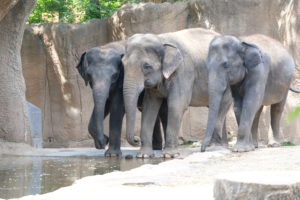Recently, I visited the beautiful, amazing, expansive St. Louis zoo. 
I hate to admit it, but walking and motivating through the zoo on that sweltering 90-degree day forced me to face my age and mortality. My heart pounded, my feet throbbed, and I was very dizzy – I honestly was worried I might harm myself with the effort. Basically, I had to slow down and make a plan. As usual, I found a philosophical way to apply the experience to my work. I thought it might help to share, because literally every one of us has to face our limitations in some way. The plan I developed that day has two basic levels of adaptation I can use for overcoming limitations as a writer – and as a person.
Here is my journal entry from that day at the zoo:
I stopped in the Kudu Cafe at the St. Louis Zoo – BEFORE going into the zoo!
I don’t know if it’s just getting old, the stroke, or the solid week of work and travel I just completed, but I was pooped already. It took some time and a lot of energy to unpack my computer and situate it under some cold bottles of water, find my hat, pack my camera into my backpack and that’s after finding a parking place on the street to save money. I had about a two-block walk, but that’s not bad. A little pasta salad, watermelon, and orange juice got me on my way. Where are those animals? My camera is ready.
The overwhelming demand of the day was obviously going to be pacing myself against the heat. I don’t know how to explain how oppressive it was. I’ve felt heat before, of course, but this was – I’m not sure how to explain it.

When I was younger, on a hot day, I would feel out of breath, sweaty, and sluggish. But I would press on, ride it out, and keep moving. Today, at the St. Louis Zoo, I felt those things times 10. I was not just out of breath, my chest fet like it might cave in. I didn’t just feel sluggish. With surprise and in disbelief, I had to stop, sit, drink more water, mop off my face and calm my pounding heart. Of course, I wasn’t the only one sweating it out in the day’s 95+ weather. I found myself hoping, if I keeled over, that some kind soul would have mercy on me and call 911!
As I sat, forcing myself to breathe slowly and deeply, I tried to figure out what the problem was. The last time I attempted to visit a zoo in the heat, it was nothing like this. What was different? Am I just getting old? Is it still effects of the stroke?
Honestly, there was no way to know. And at that moment what could I do about it? Nothing! I realized I just had to work with it. So I got my ticket to the upcoming seal show and then found a quiet place to sit behind a concession stand. That’s all. I just sat. And drank water.
While I sat, I rolled this new idea around in my head. I wasn’t going to automatically be able to hike in this kind of weather anymore. Maybe, if stroke recovery is the problem, I could exercise more and get stronger. That’s something to think about for later. Right then, I had to figure out how to deal with the zoo situation.
The thought crossed my mind that adaptation on both of these levels is necessary for work, too – deal with what’s in front of you right now, THEN make a plan to analyze the problems and create long-term solutions later.
First, let’s talk about the “right now” challenges. In a way, you just have to look at these things as emergencies—you know, when an impending danger inspires you to instinctively sum up a situation quickly then act almost instantly.
An example might be when a client calls and needs a revision RIGHT NOW. You have to decide RIGHT NOW how to juggle other clients and fit it in. OR if it’s not going to work, who will you beg mercy from and try to get an extension from? OR will you hire a subcontractor to pitch in as a ghost writer?
The key is not to think too hard or long. Trust your brain to analyze, then act. Just be sure to communicate with all clients involved to let them know what’s going on and allow them to have input into the situation if appropriate.
The second level of analysis of problems is long-term. Just as I need to come up with a long-term plan to deal with post-stroke tours of zoos, I need to recognize my long-term freelance writing challenges and make a plan to manage them, so I’m ready.
For example, one of my limitations is that I am SO not a morning person; so much so that it has sabotaged my work in the morning for—pretty much my entire life. This doesn’t always mesh with my clients’ needs, so I’ve created a plan. I always try to schedule meetings in the afternoon when I can. If a morning meeting is necessary, I set two alarms, make sure I get to sleep as early as possible, and buy a pastry I can look forward to so much it will get me to get out of bed early.
Another example of long-term planning is taking the time to learn a new computer app that saves me time in the end. It’s difficult to justify time out from billable hours to learn the program, but it will pay off later. I have taken many hours to set up and learn how to use Dragon® Naturally Speaking voice recognition software. When learning the program, I felt as though I was wasting time. But now that I’ve learned the program and it has further adapted to me voice and language patterns, it can save me as much as ¾ of the time it takes to write a marketing or P.R. piece.
To summarize: to overcome your limitations (1) identify the problem or challenge, (2) determine if it’s a long-term or short-term problem, (3) either jump (short-term) or analyze, plan and take action to learn or prepare something new (long-term).
That day at the St. Louis Zoo was an eye-opener for me. I didn’t want to admit I can no longer do the things I used to. But what a beautiful, fun place to face my new reality!

